Marketing Research Essentials
VerifiedAdded on 2023/06/04
|7
|1509
|331
AI Summary
This article discusses the research approach, sample size, type of research, proposed method of analysis and outcomes from this research in Marketing Research Essentials. The article covers the factors affecting the satisfaction of patients in public and private healthcare services in Australia. The proposed method of analysis includes statistical assessment using IBM SPSS. The article concludes with the benefits of conducting pre and post patient surveys and environment supervision with check-ups.
Contribute Materials
Your contribution can guide someone’s learning journey. Share your
documents today.
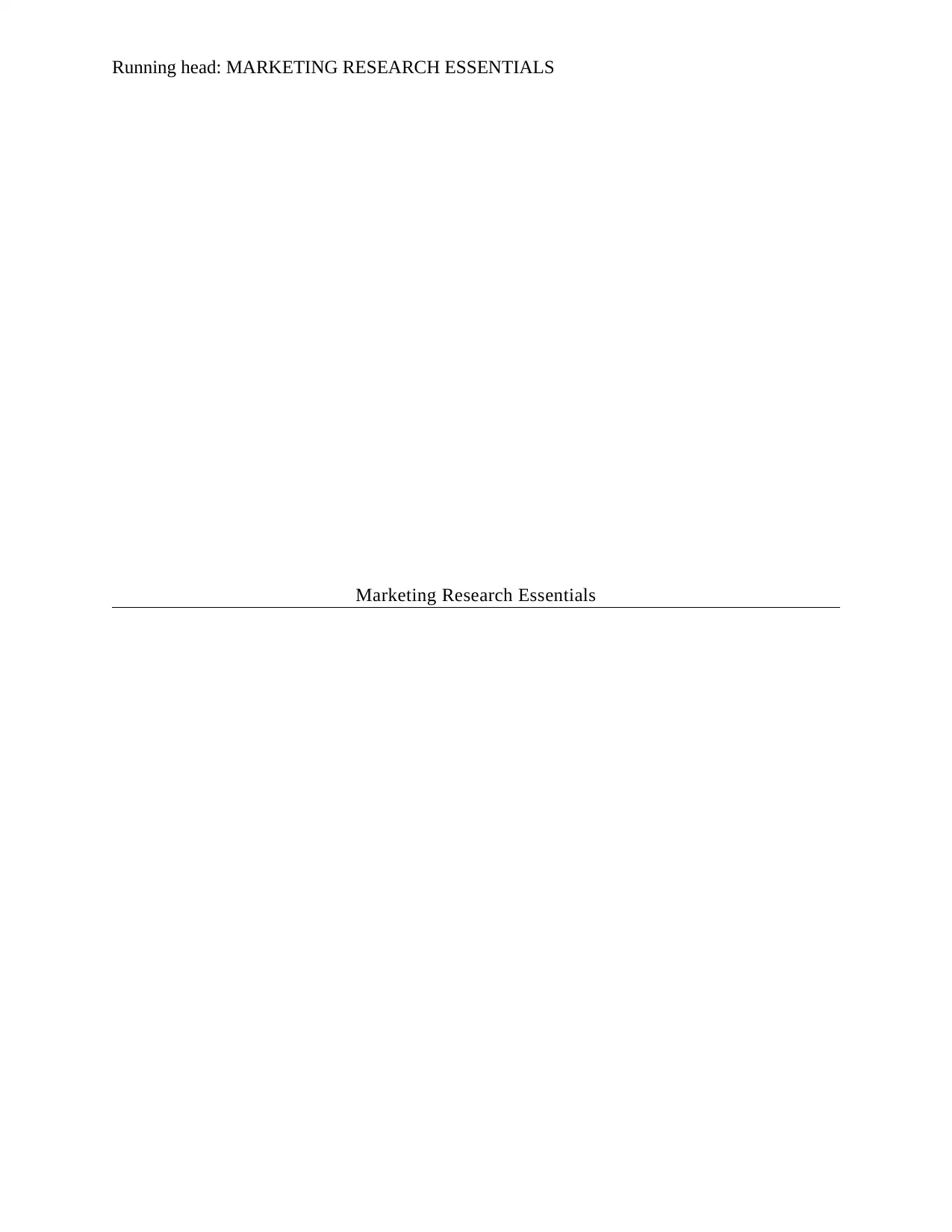
Running head: MARKETING RESEARCH ESSENTIALS
Marketing Research Essentials
Marketing Research Essentials
Secure Best Marks with AI Grader
Need help grading? Try our AI Grader for instant feedback on your assignments.
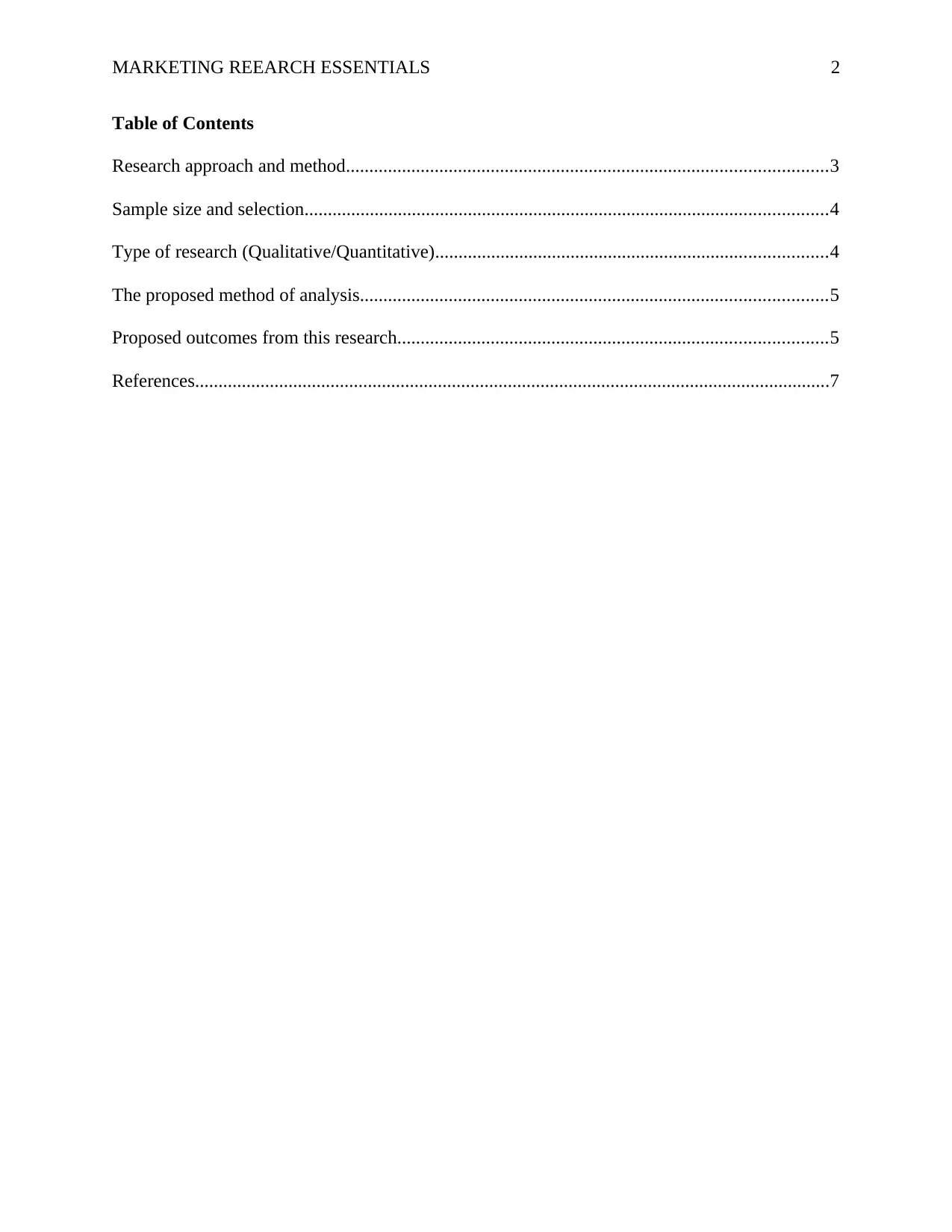
MARKETING REEARCH ESSENTIALS 2
Table of Contents
Research approach and method.......................................................................................................3
Sample size and selection................................................................................................................4
Type of research (Qualitative/Quantitative)....................................................................................4
The proposed method of analysis....................................................................................................5
Proposed outcomes from this research............................................................................................5
References........................................................................................................................................7
Table of Contents
Research approach and method.......................................................................................................3
Sample size and selection................................................................................................................4
Type of research (Qualitative/Quantitative)....................................................................................4
The proposed method of analysis....................................................................................................5
Proposed outcomes from this research............................................................................................5
References........................................................................................................................................7
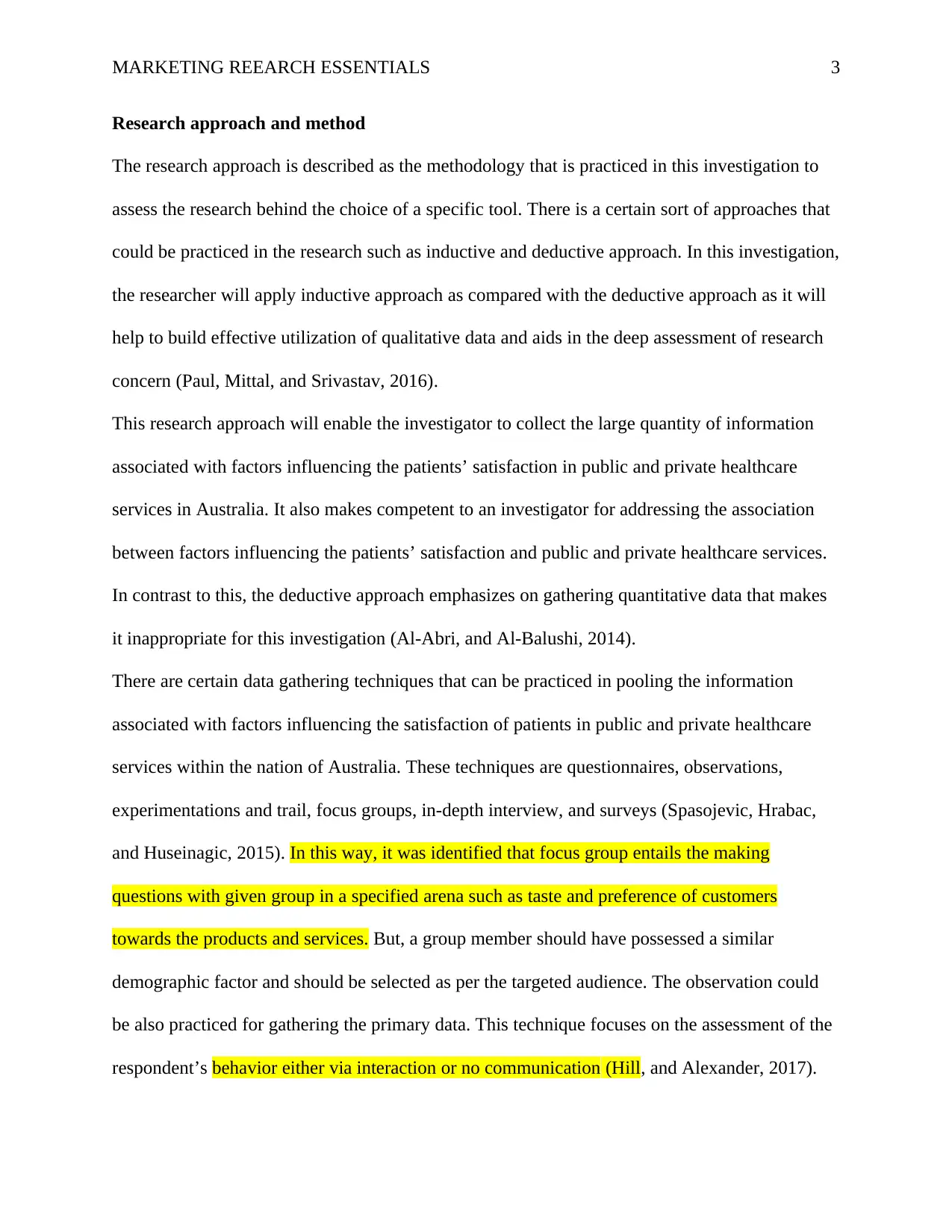
MARKETING REEARCH ESSENTIALS 3
Research approach and method
The research approach is described as the methodology that is practiced in this investigation to
assess the research behind the choice of a specific tool. There is a certain sort of approaches that
could be practiced in the research such as inductive and deductive approach. In this investigation,
the researcher will apply inductive approach as compared with the deductive approach as it will
help to build effective utilization of qualitative data and aids in the deep assessment of research
concern (Paul, Mittal, and Srivastav, 2016).
This research approach will enable the investigator to collect the large quantity of information
associated with factors influencing the patients’ satisfaction in public and private healthcare
services in Australia. It also makes competent to an investigator for addressing the association
between factors influencing the patients’ satisfaction and public and private healthcare services.
In contrast to this, the deductive approach emphasizes on gathering quantitative data that makes
it inappropriate for this investigation (Al-Abri, and Al-Balushi, 2014).
There are certain data gathering techniques that can be practiced in pooling the information
associated with factors influencing the satisfaction of patients in public and private healthcare
services within the nation of Australia. These techniques are questionnaires, observations,
experimentations and trail, focus groups, in-depth interview, and surveys (Spasojevic, Hrabac,
and Huseinagic, 2015). In this way, it was identified that focus group entails the making
questions with given group in a specified arena such as taste and preference of customers
towards the products and services. But, a group member should have possessed a similar
demographic factor and should be selected as per the targeted audience. The observation could
be also practiced for gathering the primary data. This technique focuses on the assessment of the
respondent’s behavior either via interaction or no communication (Hill, and Alexander, 2017).
Research approach and method
The research approach is described as the methodology that is practiced in this investigation to
assess the research behind the choice of a specific tool. There is a certain sort of approaches that
could be practiced in the research such as inductive and deductive approach. In this investigation,
the researcher will apply inductive approach as compared with the deductive approach as it will
help to build effective utilization of qualitative data and aids in the deep assessment of research
concern (Paul, Mittal, and Srivastav, 2016).
This research approach will enable the investigator to collect the large quantity of information
associated with factors influencing the patients’ satisfaction in public and private healthcare
services in Australia. It also makes competent to an investigator for addressing the association
between factors influencing the patients’ satisfaction and public and private healthcare services.
In contrast to this, the deductive approach emphasizes on gathering quantitative data that makes
it inappropriate for this investigation (Al-Abri, and Al-Balushi, 2014).
There are certain data gathering techniques that can be practiced in pooling the information
associated with factors influencing the satisfaction of patients in public and private healthcare
services within the nation of Australia. These techniques are questionnaires, observations,
experimentations and trail, focus groups, in-depth interview, and surveys (Spasojevic, Hrabac,
and Huseinagic, 2015). In this way, it was identified that focus group entails the making
questions with given group in a specified arena such as taste and preference of customers
towards the products and services. But, a group member should have possessed a similar
demographic factor and should be selected as per the targeted audience. The observation could
be also practiced for gathering the primary data. This technique focuses on the assessment of the
respondent’s behavior either via interaction or no communication (Hill, and Alexander, 2017).
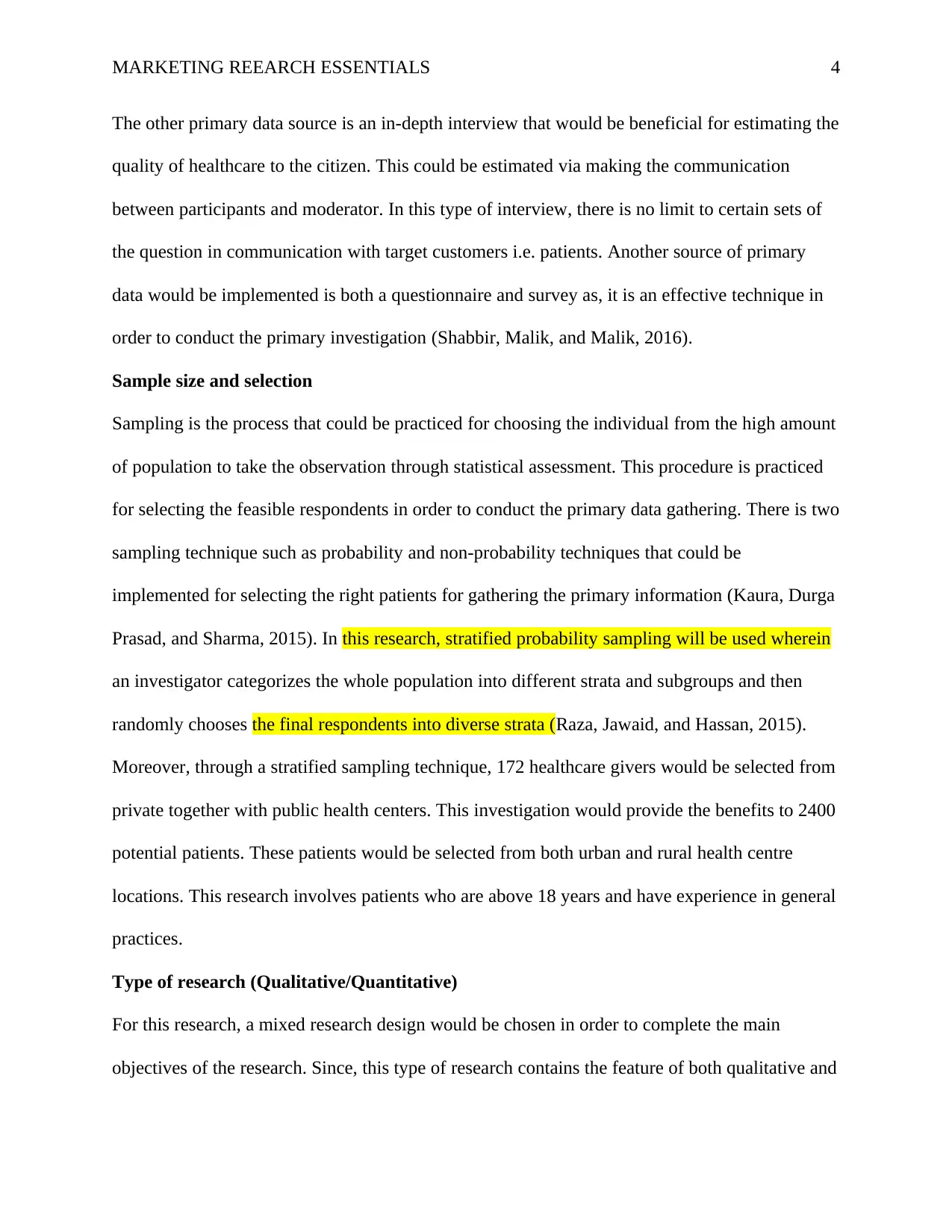
MARKETING REEARCH ESSENTIALS 4
The other primary data source is an in-depth interview that would be beneficial for estimating the
quality of healthcare to the citizen. This could be estimated via making the communication
between participants and moderator. In this type of interview, there is no limit to certain sets of
the question in communication with target customers i.e. patients. Another source of primary
data would be implemented is both a questionnaire and survey as, it is an effective technique in
order to conduct the primary investigation (Shabbir, Malik, and Malik, 2016).
Sample size and selection
Sampling is the process that could be practiced for choosing the individual from the high amount
of population to take the observation through statistical assessment. This procedure is practiced
for selecting the feasible respondents in order to conduct the primary data gathering. There is two
sampling technique such as probability and non-probability techniques that could be
implemented for selecting the right patients for gathering the primary information (Kaura, Durga
Prasad, and Sharma, 2015). In this research, stratified probability sampling will be used wherein
an investigator categorizes the whole population into different strata and subgroups and then
randomly chooses the final respondents into diverse strata (Raza, Jawaid, and Hassan, 2015).
Moreover, through a stratified sampling technique, 172 healthcare givers would be selected from
private together with public health centers. This investigation would provide the benefits to 2400
potential patients. These patients would be selected from both urban and rural health centre
locations. This research involves patients who are above 18 years and have experience in general
practices.
Type of research (Qualitative/Quantitative)
For this research, a mixed research design would be chosen in order to complete the main
objectives of the research. Since, this type of research contains the feature of both qualitative and
The other primary data source is an in-depth interview that would be beneficial for estimating the
quality of healthcare to the citizen. This could be estimated via making the communication
between participants and moderator. In this type of interview, there is no limit to certain sets of
the question in communication with target customers i.e. patients. Another source of primary
data would be implemented is both a questionnaire and survey as, it is an effective technique in
order to conduct the primary investigation (Shabbir, Malik, and Malik, 2016).
Sample size and selection
Sampling is the process that could be practiced for choosing the individual from the high amount
of population to take the observation through statistical assessment. This procedure is practiced
for selecting the feasible respondents in order to conduct the primary data gathering. There is two
sampling technique such as probability and non-probability techniques that could be
implemented for selecting the right patients for gathering the primary information (Kaura, Durga
Prasad, and Sharma, 2015). In this research, stratified probability sampling will be used wherein
an investigator categorizes the whole population into different strata and subgroups and then
randomly chooses the final respondents into diverse strata (Raza, Jawaid, and Hassan, 2015).
Moreover, through a stratified sampling technique, 172 healthcare givers would be selected from
private together with public health centers. This investigation would provide the benefits to 2400
potential patients. These patients would be selected from both urban and rural health centre
locations. This research involves patients who are above 18 years and have experience in general
practices.
Type of research (Qualitative/Quantitative)
For this research, a mixed research design would be chosen in order to complete the main
objectives of the research. Since, this type of research contains the feature of both qualitative and
Secure Best Marks with AI Grader
Need help grading? Try our AI Grader for instant feedback on your assignments.
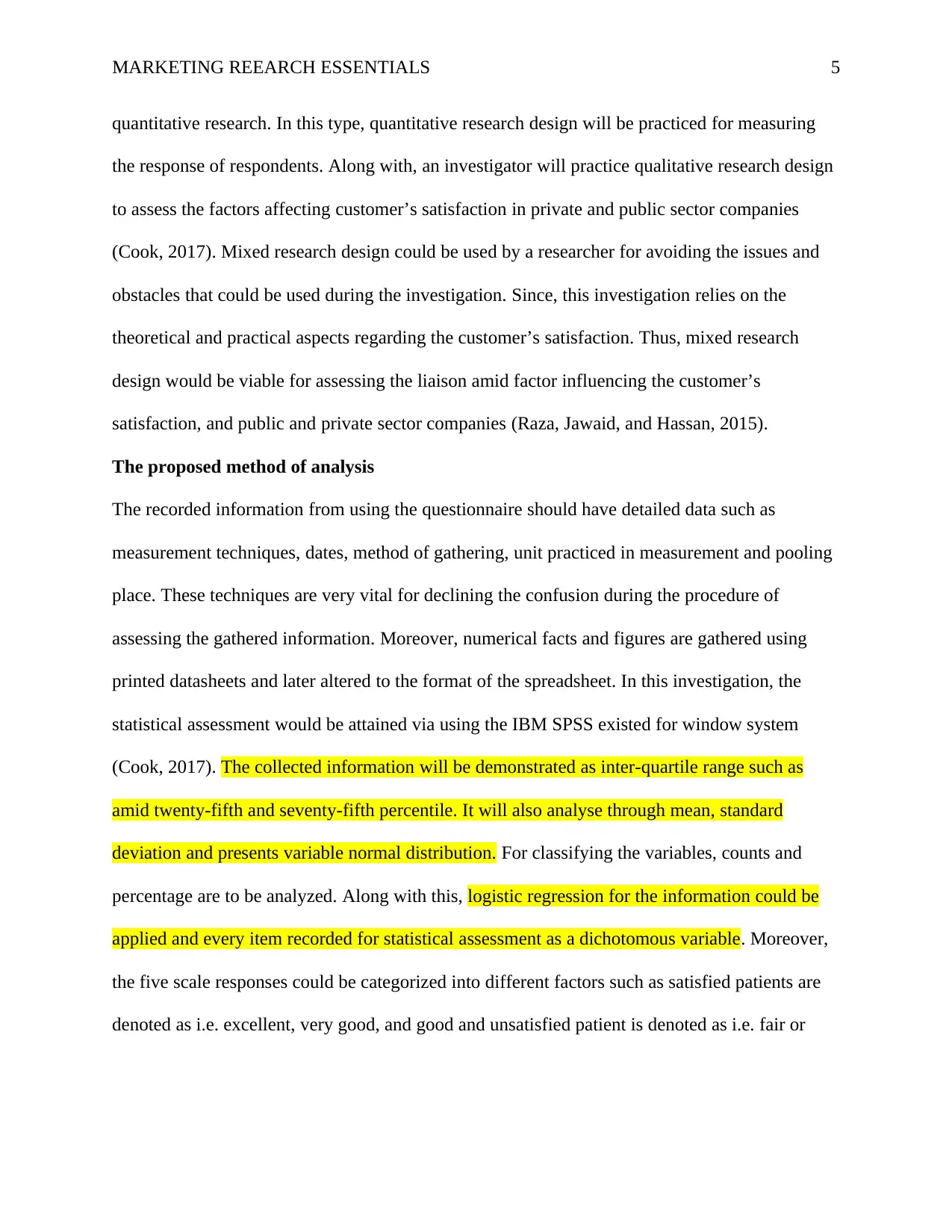
MARKETING REEARCH ESSENTIALS 5
quantitative research. In this type, quantitative research design will be practiced for measuring
the response of respondents. Along with, an investigator will practice qualitative research design
to assess the factors affecting customer’s satisfaction in private and public sector companies
(Cook, 2017). Mixed research design could be used by a researcher for avoiding the issues and
obstacles that could be used during the investigation. Since, this investigation relies on the
theoretical and practical aspects regarding the customer’s satisfaction. Thus, mixed research
design would be viable for assessing the liaison amid factor influencing the customer’s
satisfaction, and public and private sector companies (Raza, Jawaid, and Hassan, 2015).
The proposed method of analysis
The recorded information from using the questionnaire should have detailed data such as
measurement techniques, dates, method of gathering, unit practiced in measurement and pooling
place. These techniques are very vital for declining the confusion during the procedure of
assessing the gathered information. Moreover, numerical facts and figures are gathered using
printed datasheets and later altered to the format of the spreadsheet. In this investigation, the
statistical assessment would be attained via using the IBM SPSS existed for window system
(Cook, 2017). The collected information will be demonstrated as inter-quartile range such as
amid twenty-fifth and seventy-fifth percentile. It will also analyse through mean, standard
deviation and presents variable normal distribution. For classifying the variables, counts and
percentage are to be analyzed. Along with this, logistic regression for the information could be
applied and every item recorded for statistical assessment as a dichotomous variable. Moreover,
the five scale responses could be categorized into different factors such as satisfied patients are
denoted as i.e. excellent, very good, and good and unsatisfied patient is denoted as i.e. fair or
quantitative research. In this type, quantitative research design will be practiced for measuring
the response of respondents. Along with, an investigator will practice qualitative research design
to assess the factors affecting customer’s satisfaction in private and public sector companies
(Cook, 2017). Mixed research design could be used by a researcher for avoiding the issues and
obstacles that could be used during the investigation. Since, this investigation relies on the
theoretical and practical aspects regarding the customer’s satisfaction. Thus, mixed research
design would be viable for assessing the liaison amid factor influencing the customer’s
satisfaction, and public and private sector companies (Raza, Jawaid, and Hassan, 2015).
The proposed method of analysis
The recorded information from using the questionnaire should have detailed data such as
measurement techniques, dates, method of gathering, unit practiced in measurement and pooling
place. These techniques are very vital for declining the confusion during the procedure of
assessing the gathered information. Moreover, numerical facts and figures are gathered using
printed datasheets and later altered to the format of the spreadsheet. In this investigation, the
statistical assessment would be attained via using the IBM SPSS existed for window system
(Cook, 2017). The collected information will be demonstrated as inter-quartile range such as
amid twenty-fifth and seventy-fifth percentile. It will also analyse through mean, standard
deviation and presents variable normal distribution. For classifying the variables, counts and
percentage are to be analyzed. Along with this, logistic regression for the information could be
applied and every item recorded for statistical assessment as a dichotomous variable. Moreover,
the five scale responses could be categorized into different factors such as satisfied patients are
denoted as i.e. excellent, very good, and good and unsatisfied patient is denoted as i.e. fair or
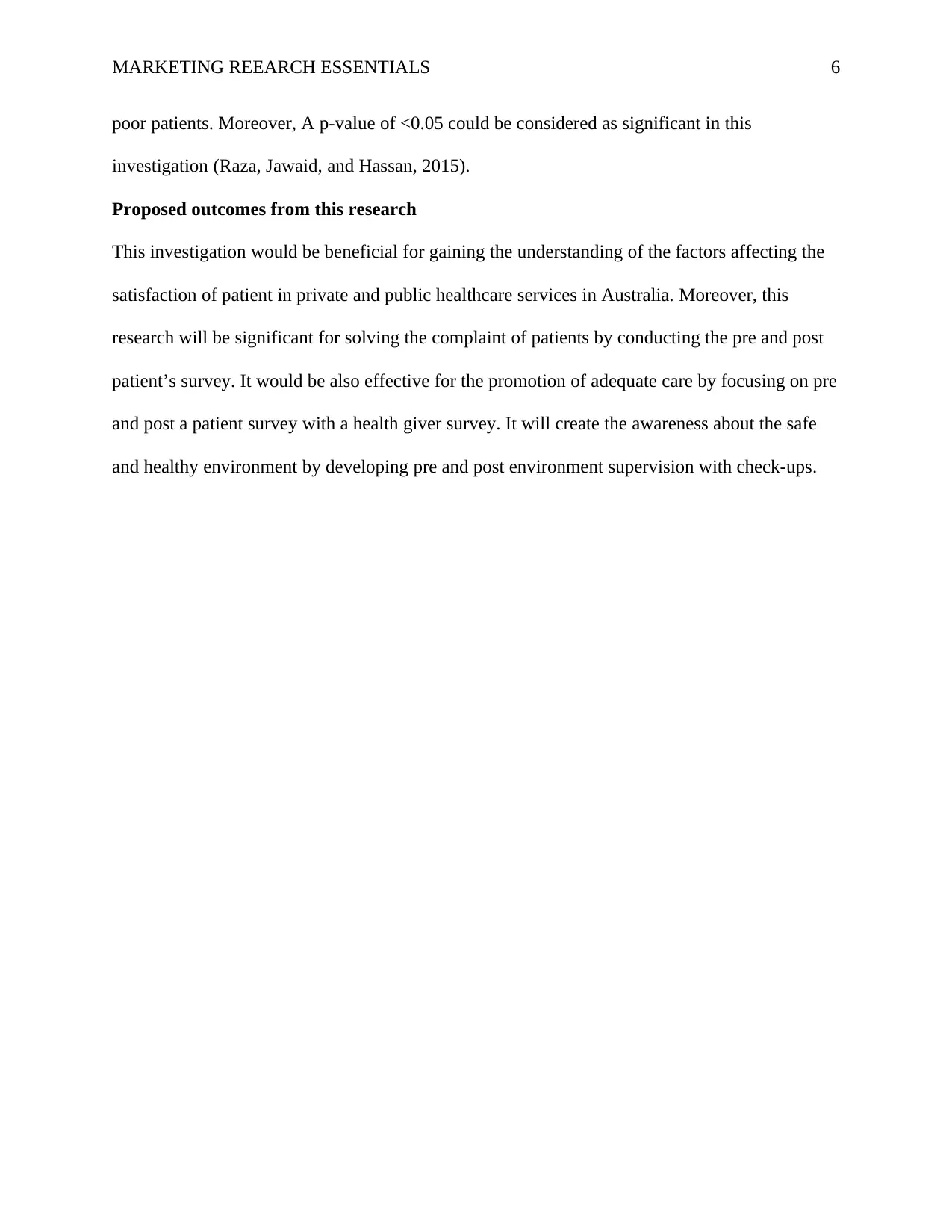
MARKETING REEARCH ESSENTIALS 6
poor patients. Moreover, A p-value of <0.05 could be considered as significant in this
investigation (Raza, Jawaid, and Hassan, 2015).
Proposed outcomes from this research
This investigation would be beneficial for gaining the understanding of the factors affecting the
satisfaction of patient in private and public healthcare services in Australia. Moreover, this
research will be significant for solving the complaint of patients by conducting the pre and post
patient’s survey. It would be also effective for the promotion of adequate care by focusing on pre
and post a patient survey with a health giver survey. It will create the awareness about the safe
and healthy environment by developing pre and post environment supervision with check-ups.
poor patients. Moreover, A p-value of <0.05 could be considered as significant in this
investigation (Raza, Jawaid, and Hassan, 2015).
Proposed outcomes from this research
This investigation would be beneficial for gaining the understanding of the factors affecting the
satisfaction of patient in private and public healthcare services in Australia. Moreover, this
research will be significant for solving the complaint of patients by conducting the pre and post
patient’s survey. It would be also effective for the promotion of adequate care by focusing on pre
and post a patient survey with a health giver survey. It will create the awareness about the safe
and healthy environment by developing pre and post environment supervision with check-ups.
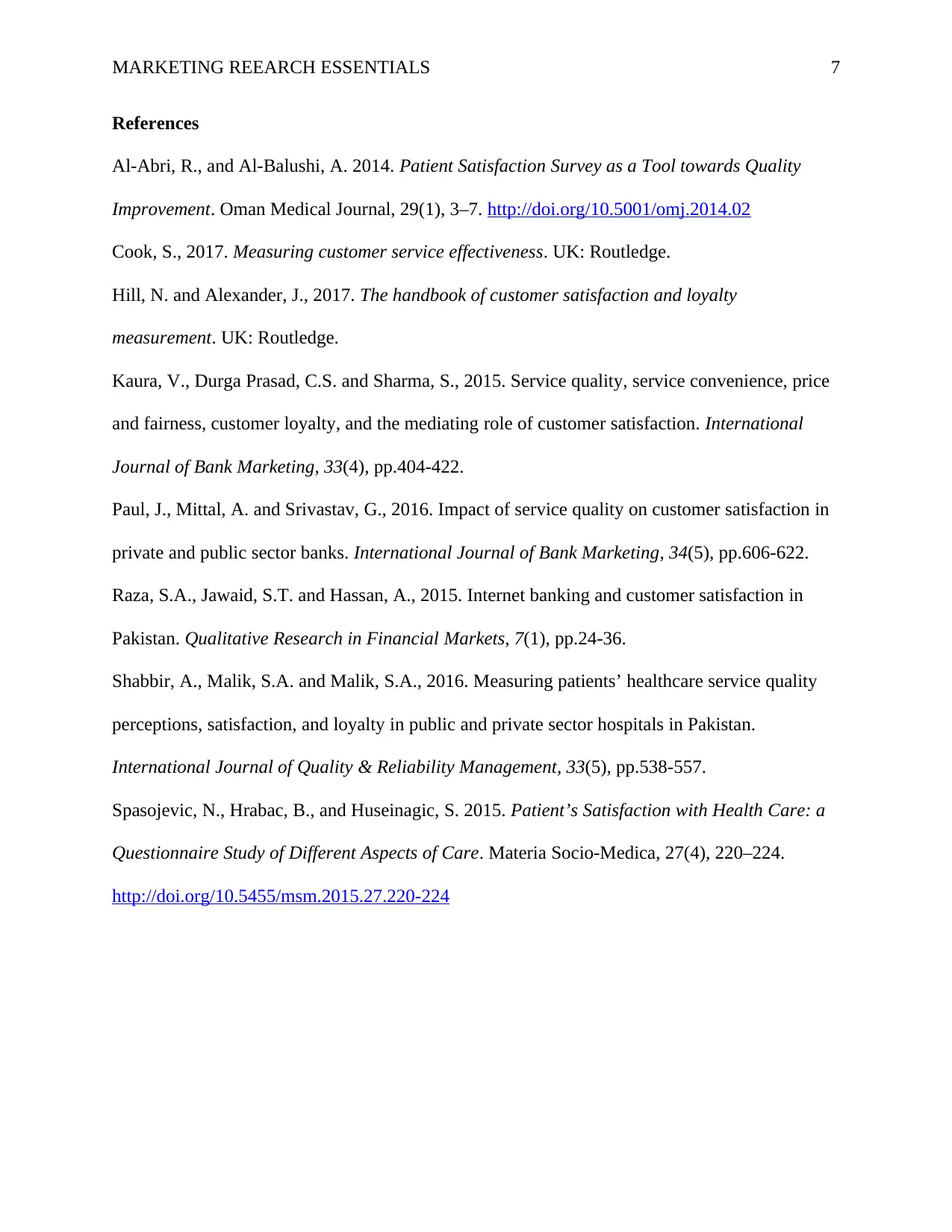
MARKETING REEARCH ESSENTIALS 7
References
Al-Abri, R., and Al-Balushi, A. 2014. Patient Satisfaction Survey as a Tool towards Quality
Improvement. Oman Medical Journal, 29(1), 3–7. http://doi.org/10.5001/omj.2014.02
Cook, S., 2017. Measuring customer service effectiveness. UK: Routledge.
Hill, N. and Alexander, J., 2017. The handbook of customer satisfaction and loyalty
measurement. UK: Routledge.
Kaura, V., Durga Prasad, C.S. and Sharma, S., 2015. Service quality, service convenience, price
and fairness, customer loyalty, and the mediating role of customer satisfaction. International
Journal of Bank Marketing, 33(4), pp.404-422.
Paul, J., Mittal, A. and Srivastav, G., 2016. Impact of service quality on customer satisfaction in
private and public sector banks. International Journal of Bank Marketing, 34(5), pp.606-622.
Raza, S.A., Jawaid, S.T. and Hassan, A., 2015. Internet banking and customer satisfaction in
Pakistan. Qualitative Research in Financial Markets, 7(1), pp.24-36.
Shabbir, A., Malik, S.A. and Malik, S.A., 2016. Measuring patients’ healthcare service quality
perceptions, satisfaction, and loyalty in public and private sector hospitals in Pakistan.
International Journal of Quality & Reliability Management, 33(5), pp.538-557.
Spasojevic, N., Hrabac, B., and Huseinagic, S. 2015. Patient’s Satisfaction with Health Care: a
Questionnaire Study of Different Aspects of Care. Materia Socio-Medica, 27(4), 220–224.
http://doi.org/10.5455/msm.2015.27.220-224
References
Al-Abri, R., and Al-Balushi, A. 2014. Patient Satisfaction Survey as a Tool towards Quality
Improvement. Oman Medical Journal, 29(1), 3–7. http://doi.org/10.5001/omj.2014.02
Cook, S., 2017. Measuring customer service effectiveness. UK: Routledge.
Hill, N. and Alexander, J., 2017. The handbook of customer satisfaction and loyalty
measurement. UK: Routledge.
Kaura, V., Durga Prasad, C.S. and Sharma, S., 2015. Service quality, service convenience, price
and fairness, customer loyalty, and the mediating role of customer satisfaction. International
Journal of Bank Marketing, 33(4), pp.404-422.
Paul, J., Mittal, A. and Srivastav, G., 2016. Impact of service quality on customer satisfaction in
private and public sector banks. International Journal of Bank Marketing, 34(5), pp.606-622.
Raza, S.A., Jawaid, S.T. and Hassan, A., 2015. Internet banking and customer satisfaction in
Pakistan. Qualitative Research in Financial Markets, 7(1), pp.24-36.
Shabbir, A., Malik, S.A. and Malik, S.A., 2016. Measuring patients’ healthcare service quality
perceptions, satisfaction, and loyalty in public and private sector hospitals in Pakistan.
International Journal of Quality & Reliability Management, 33(5), pp.538-557.
Spasojevic, N., Hrabac, B., and Huseinagic, S. 2015. Patient’s Satisfaction with Health Care: a
Questionnaire Study of Different Aspects of Care. Materia Socio-Medica, 27(4), 220–224.
http://doi.org/10.5455/msm.2015.27.220-224
1 out of 7
Related Documents
Your All-in-One AI-Powered Toolkit for Academic Success.
+13062052269
info@desklib.com
Available 24*7 on WhatsApp / Email
![[object Object]](/_next/static/media/star-bottom.7253800d.svg)
Unlock your academic potential
© 2024 | Zucol Services PVT LTD | All rights reserved.




